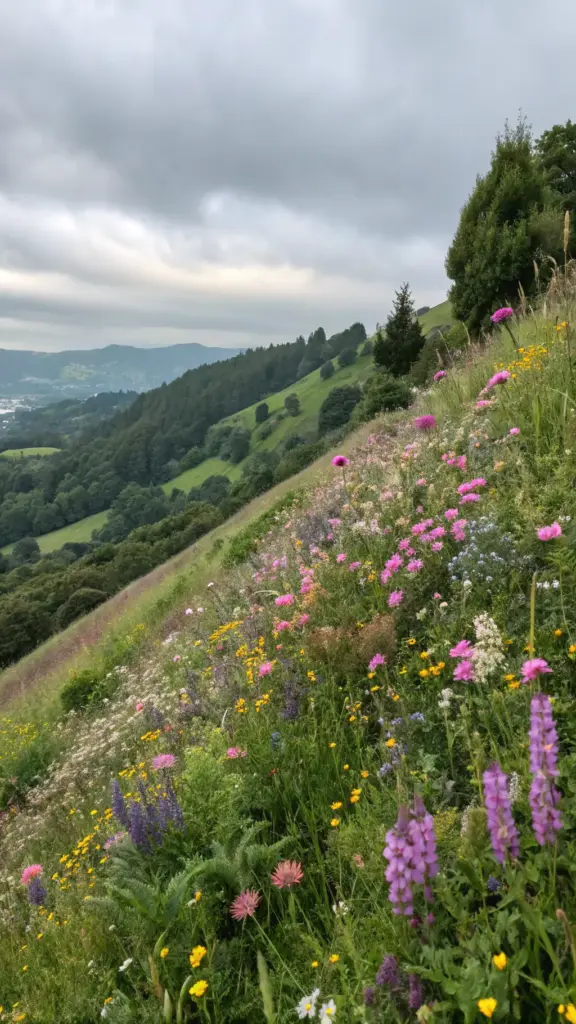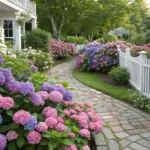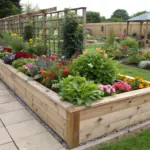2. Wildflower Wonderland: Creating a Natural, Effortless Hillside

There’s something about a hill covered in wildflowers that feels like pure magic. It’s like Mother Nature herself decided to throw a party and invited all her favorite blooms. I’ll admit, when I first tried planting wildflowers, I thought it would be as simple as tossing seeds and walking away. Spoiler alert: it’s not quite that easy, but it’s close! Over the years, I’ve learned how to create a wildflower wonderland that looks effortlessly beautiful while staying low-maintenance. Let me share my tips with you.
Choosing Native Wildflowers for a Natural Look
Here’s the secret to a successful wildflower garden: go native. Native wildflowers are adapted to your region’s climate and soil, which means they’re more likely to thrive without much fuss.
I made the mistake of ordering a generic wildflower mix once—it looked great on paper, but half the plants didn’t survive our hot summers. Lesson learned. Now, I always research what grows naturally in my area. For example, if you live in Los Angeles, California poppies are a no-brainer. Their bright orange blooms scream sunshine and happiness. In cooler climates, try lupines or black-eyed Susans. Trust me, sticking with native species will save you time, money, and heartache.
Step-by-Step Guide to Seeding a Wildflower Hill
Planting wildflowers isn’t rocket science, but there’s a method to the madness. Here’s how I do it:
- Prepare the soil: Clear the hill of weeds and debris, but don’t over-till it. Wildflowers actually prefer a bit of roughness to anchor their roots.
- Mix seeds with sand: This trick helps you see where you’ve scattered the seeds. I use a 4:1 ratio of sand to seeds—it’s a game-changer.
- Broadcast the seeds: Toss them evenly across the hill. Don’t worry about perfection; wildflowers look best when they’re a little random.
- Press, don’t bury: Gently press the seeds into the soil with your hands or a roller. Covering them too deeply is a rookie mistake I’ve made more times than I care to admit.
Once you’ve seeded, water lightly every day until the sprouts appear. After that, let nature take the wheel.
Best Wildflower Mixes for Specific Climates
Not all wildflower mixes are created equal. If you’re in a dry, sunny spot like LA, go for drought-tolerant mixes featuring California poppies, globe gilia, and tidy tips. These bad boys can handle the heat.
In wetter climates, like Seattle, try mixes with columbines, forget-me-nots, and foxgloves. These plants love moisture and will reward you with lush blooms. And if you’re somewhere in between, like Chicago, a balanced mix of sun-lovers and shade-tolerant flowers works wonders.
Pro tip: Always check the seed packet for bloom times. Mixing early, mid, and late bloomers ensures your hill stays colorful from spring to fall.
Maintenance Tips to Keep Weeds at Bay
Let’s talk weeds—because nothing ruins a wildflower wonderland faster than invasive grasses taking over. The key is timing.
After seeding, keep an eye out for weeds during the first few weeks. Pull them by hand (tedious, I know) or use a hoe to avoid disturbing your precious wildflowers. Once the flowers establish themselves, they’ll outcompete most weeds. Another trick? Mulch lightly around the edges of your hill to suppress weed growth without smothering your blooms.
And here’s the thing: don’t stress too much. A few weeds won’t ruin the vibe. Wildflower gardens are supposed to look a little untamed. That’s part of their charm.
Alright, ready to take your gardening skills up another notch? Click the next button below to learn how terraced tulips can add structure and elegance to your hillside. Spoiler: it’s easier than you think, and the results are absolutely stunning!









GIPHY App Key not set. Please check settings